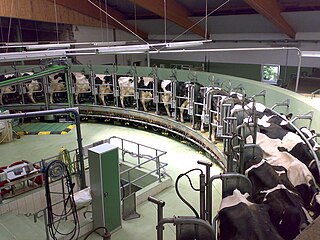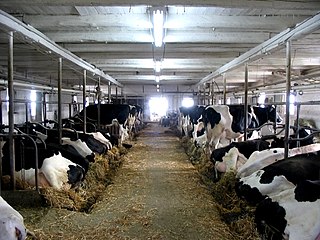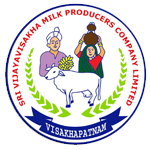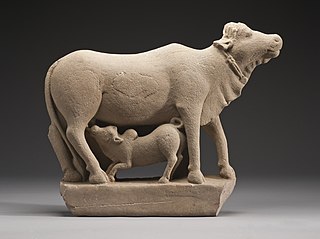
Dairy farming is a class of agriculture for long-term production of milk, which is processed for eventual sale of a dairy product.

Dairy cattle are cattle bred for the ability to produce large quantities of milk, from which dairy products are made. Dairy cattle generally are of the species Bos taurus.

The Murrah buffalo is a breed of water buffalo mainly kept for milk production. It originates in Haryana and Punjab of India, where it is kept in the districts of Bhiwani, Hisar, Rohtak, Jind, Jhajhar, Fatehabad, Gurgaon and the capital region of Delhi. It has been used to improve the milk production of dairy buffalo in other countries, such as Italy, Bulgaria and Egypt. A Murrah buffalo at the Lakshmi Dairy Farm in Punjab set a record of 26.335 kg (58.06 lb) of milk in the 2016 National Livestock Competition and Expo. In Brazil, this breed of buffalo is used for production of both meat and milk. Murrahs sell for a high price.
The Karnataka Milk Federation (KMF) is a statutory corporation under the ownership of Ministry of Fisheries, Animal Husbandry and Dairying, Government of Karnataka from Karnataka, India, which sells products such as milk, curds, ghee, butter, ice cream and sweets under the brand name Nandini which is a wholly owned subsidiary of National Dairy Development Board, Ministry of Fisheries, Animal Husbandry and Dairying, Government of India. It is a federation of milk producers association working on cooperative principles. Almost every district in state of Karnataka has milk producing co-operatives. The milk is collected from farmers who are its members, processed and sold in the market by the brand of Nandini. It is the second largest milk co-operative in India after Amul.

Chandra Shekhar Azad University of Agriculture & Technology (CSAUA&T) is an agricultural university at Kanpur in the Indian state of Uttar Pradesh. It is named after the Indian revolutionary Chandrashekhar Azad. Besides Kanpur, it also has constituent colleges in Etawah and Lakhimpur Kheri district who are fully functional and an upcoming in Hardoi. The university caters to the needs of the farming community of 29 districts of Uttar Pradesh.
Animal husbandry in Himachal Pradesh plays a very major role in the development of agricultural sector of Himachal. Indigenous breeds of cows, buffalo and sheep are of very poor quality.
Numerous schemes for cattle development, cattle health and disease resistance in wood production, poultry development, feed and fodder development, dairy improvement, milk supply schemes and veterinary education has been undertaken in order to improve the livestock in the state. There are many veterinary hospitals, dispensaries and outlying dispensaries in the state to provide veterinary aids and to take measures against various contagious diseases. A number of mobile dispensaries are also in operation.
Recently, Angora rabbits imported from West Germany were introduced in the state. Now 7 units for their propagation have been set up in Kangra.
Milk production has also increased. Milk chilling plants with a capacity of about 55,000 liters have been set up at about 24 places and departmental milk supply schemes are operational in 6 towns.

Many farmers in India depend on animal husbandry for their livelihood. In addition to supplying milk, meat, eggs, wool, their castings (dung) and hides, animals, mainly bullocks, are the major source of power for both farmers and dairies. Thus, animal husbandry plays an important role in the rural economy. The gross value of output from this sector was 8,123 billion Rupees in FY 2015-16.
The Aryavart Bank (AB) is an Indian Regional Rural Bank (RRB) in Uttar Pradesh established on 1 April 2019. The bank was formed by the amalgamation of Gramin Bank of Aryavart and Allahabad UP Gramin Bank. It currently has 1365 branches and 22 regional offices in rural areas of Uttar Pradesh, around Lucknow. It functions under Regional Rural Banks' Act 1976 and is sponsored by Bank of India.Allahabad UP Gramin Bank and Gramin Bank of Aryavart are mergering with name Aryavart Bank e.r.f 01.04.2019. It is under the ownership of Ministry of Finance, Government of India.
Bhanu Pratap Singh was Member of Parliament in the eighth Lok Sabha from Pilibhit Constituency elected in 1984 on Congress (I)'s ticket. Bhanu Pratap Singh is son of Daulat Rai Yadubansi, who was agriculturist by profession in Agras Village, which comes under limits of Bareilly district, Uttar Pradesh.
In Sri Lanka many farmers depend on animal husbandry for their livelihood, but not a large proportion. Therefore, many livestock products have to be imported. The main livestock products in Sri Lanka are milk, meat and eggs. Hides, wools and other products are still not produced within the country. Animal power formerly used in the cultivation of rice and vegetables have been replaced by modern technology to farmlands. However animal husbandry plays an important role in the rural economy for improving the living conditions of farmers in the country.

Dairy farming is one of the largest agricultural sectors in Canada. Dairy has a significant presence in all of the provinces and is one of the top two agricultural commodities in seven out of ten provinces.
Dara Nusserwanji Khurody was an Indian entrepreneur known for his contributions to the dairy industry of India. He worked in various private and government organization at the start of his career and also held government official positions later on. He was the Milk Commissioner of Bombay from 1946 to 1952. His name was considered "synonymous with dairying" in India in the 1950s. He received the Ramon Magsaysay Award jointly with Verghese Kurien and Tribhuvandas Kishibhai Patel in 1963 and the Padma Bhushan from the Government of India in 1964.
Akhilesh Yadav, the Chief Minister of Uttar Pradesh announced the Uttar Pradesh Budget for 2016-17 on 12 February 2016. According to the Budget, the year 2016-17 has been announced to be the Year of the Youth and the Farmers. It was presented in Vidhan Sabha, Lucknow before the Governor and joint session of the two Houses. The ₹3.46 lakh crore (US$46 billion) Budget 2016-17 was 14% more than 2015-2016.
Central Institute for Research on Buffaloes, Hisar, a publicly funded, institute for water buffalo research. It is located 170 kilometres (110 mi) from Delhi, at Hisar in the north Indian state of Haryana. It has a sub-campus, Bir Dosanjh, at Nabha. CIRB operates a nationwide network of 10 research centres working on breed improvement of the 7 main native breeds. CIRB, with over 20 laboratories for buffalo research, is the world's largest buffalo research institute with the widest range of breeds under study. With the aim of improving breeds and dissemination of information, CIRB has sold over 1,000 bulls, conducted ~200,000 artificial insemination in the field for the farmers’ buffaloes with a 41% conception rate, distributed ~520,000 progeny tested frozen semen kits to 45,000 farmers and over 250 institutes, imparted training to several thousand farmers on advanced buffalo husbandry, and created the world's first online Buffalopedia in several languages. It has a large research partner network across India and the globe. It is the second institute to successfully clone a buffalo in 2016, after the first successful cloning was achieved by the National Dairy Research Institute, Karnal in 2010. In July 2017, the Indian Council of Agricultural Research ranked CIRB Hisar as India's number one Buffalo research institute for the year 2016–17.

Alok Ranjan is a retired 1978 batch IAS officer from the U.P Cadre. He retired on 1 July 2016 after holding the office of Chief Secretary for the Government of Uttar Pradesh for over two years. Prior to this he has held various portfolios including Infrastructure and Industrial Development Commissioner (IIDC) and Agriculture Production Commissioner (APC) for the state of Uttar Pradesh.
e - Pashu Haatis a web portal launched by the Ministry of Agriculture and Farmers Welfare, Government of India, under the Department of Animal Husbandry, Dairying and Fisheries (DADF) to boost dairy productivity in India by organizing the livestock market. The portal allows farmers and entrepreneurs find information about bovine animals, buy or sell livestock, frozen semen and embryos. It also helps them to check information on feed and fodder and manage the transportation of animals once a purchase is made. A multi-channel communication system, via, video, email, SMS, audio and chat is available to let interested stakeholders, including buyers and sellers communicate.

Sri Vijaya Visakha Milk Producers Company Ltd( ) is a statutory corporation under the ownership of Ministry of Fisheries, Animal Husbandry and Darying, Government of Andhra Pradesh in the Indian state of Andhra Pradesh. It sells products such as pedha, paneer, curds and milk in the name of Visakha Dairy. It works on cooperative principles. Almost every North Coastal district in the state has milk producing co-operatives. The milk is collected from member farmers, processed and sold in the market under the brand of Visakha Dairy. It is the largest milk co-operative in the state.

Dairy plays a significant part in numerous aspects of Indian society, including cuisine, religion, culture, and the economy.
Tribal Co-operative Marketing Development Federation of India (TRIFED) is a national level cooperative body under the administrative control of Ministry of Tribal Affairs, Government of India. It was established under the Multi-state co-operative societies act 1984 under the former Ministry of Welfare. Later it came under the control of Ministry of Tribal affairs. In order to empower the downtrodden tribal community it started the procurement of tribal art and craft items firstly in 1999 through its retail outlet called Tribes India.
The Department of Animal husbandry and Dairying (DAHD) is an Indian government department. It is a subsidiary department of the Ministry of Animal Husbandry, Dairying and Fisheries which was formed as a new Indian ministry in 2019. The DAHD or the erstwhile Department of Animal husbandry, Fishiries and Dairying was formed in 1991 by merging together into a separate department, of two divisions of Department of Agriculture and Cooperation namely Animal husbandry and Dairy development.In 1997 the fishiries division of Department of Agriculture and Cooperation and a part of Ministry of Food Processing Industries was transferred to it. In February 2019 the Department of Fishiries was carved out from the Department of Animal husbandry, Dairying and Fisheries and it has been functioning as Department of Animal husbandry and Dairying since then.







